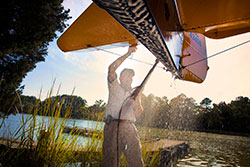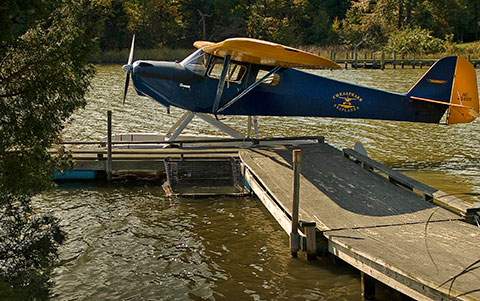Challenges: River dance
Floatplane flying combines the best of both worlds
Jeff Skiles makes it official
His unplanned water landing in the Hudson River in 2009 sparked headlines around the world, but in October 2011 Jeff Skiles made it official. The first officer of US Airways Flight 1549 got a single-engine seaplane rating in Wisconsin. Skiles quipped that he is now rated to take off and land on water in the same airplane, according to The Ozaukee Press. Flight 1549, an Airbus A320, made an emergency landing on the Hudson River following the failure of both engines after multiple bird strikes.
Photography by Chris Rose
Let’s all tip our caps to aviation pioneer Glenn Curtiss, who was one of the first to brainstorm the possibility of marrying a boat to an airplane. Curtiss attached pontoons to a biplane and managed to get airborne in 1911, and pilots have enjoyed both the utility and the fun of being able to land and take off on water ever since.
A seaplane rating has been on my to-do list for about as long as I’ve had a pilot certificate, but the time commitment to travel to Florida or Maine or Alaska had put the project on a way-far-back burner. When this installment of AOPA Pilot’s “Challenge” series came to me, I decided to see if there were any floatplane instructors in Maryland. After all, the Chesapeake Bay bisects our state, and we have a handful of seaplane bases.
With the help of the Seaplane Pilots Association directory, I struck gold: Stan Sweikar runs a seasonal operation called Chesapeake Seaplanes in the very southernmost part of Maryland. He operates from April to November, and is a consultant for Computer Sciences Corporation during the off-season.
 Stan Sweikar uses a Ford tractor and a dolly to put N43459 in the water (left), then positions the Taylorcraft against the dock (right).
Stan Sweikar uses a Ford tractor and a dolly to put N43459 in the water (left), then positions the Taylorcraft against the dock (right).
Sweikar and his wife, Sandy, keep horses—hers—and airplanes—his—at their home in a quiet neighborhood on St. Jerome’s Creek, a tributary of the Chesapeake Bay. A barn on the property serves double duty as a hangar. A tidy one-story frame building turns out to be Sandy’s shop, where she makes and repairs marine canvas.
While Sweikar finishes up with a client—a rated pilot who needed a floatplane fix—I get some friendly attention from his Jack Russell. The rough-coated terrier named Binky will follow us down to the dock and be waiting there for us when we return.
Bathing beauty
A pristine 1946 Taylorcraft BCS12D-4-85 is tied up at the dock. Painted in the sprightly blue-and-yellow color scheme of a Stearman, N43459 sports EDO-1320 floats of the same vintage as the airplane.
 Taxiing out for the photo shoot, the author and Sweikar wound up doing one extra takeoff and landing. “It’s just too much fun,” Sweikar said.
Taxiing out for the photo shoot, the author and Sweikar wound up doing one extra takeoff and landing. “It’s just too much fun,” Sweikar said.
The airplane is bobbing gently on the brackish water. Each day, Sweikar hauls it out of the water and hoses it down thoroughly with Salt-Away, a biodegradable solution. “Just washing the floats with water doesn’t do the job,” he explains. “There’s a lot of corrosion control and preventive maintenance…this is why the Navy doesn’t use seaplanes.”
I ask Sweikar if we can do a little bit of everything, and he’s happy to oblige, instructing me to untie the airplane’s tack line and climb in. (“You’re not a sailor, I take it,” he observes as my fingers struggle with the knots.)
When buckled into the Taylorcraft, I have an overwhelming urge to simply sit in the cockpit and contemplate
the surroundings—sun-dappled water, a heron picking its way through the shallows—but I’m here to learn.
Floatplane flying is dynamic. If you think your airport is busy, try throwing kayakers, Jet-Ski drivers, water skiers, boats of every description, and waterfowl into the mix. “Waterway incursions are a possibility with every landing and every takeoff,” Sweikar says.
As we fire up the 85-horsepower Continental and begin a careful, measured taxi out to the middle of the creek, water rudders attached to the floats help us maneuver the airplane to the open water. They have to be retracted before each takeoff. Sweikar teaches his students to use the mnemonic CARS—Carb heat cold, Area clear, Rudder retracted, Stick/yoke back.
You can’t use the water behind you
Our first takeoff is not a matter of adding full power, waiting for the proper airspeed, and then rotating. Instead, we’ve got to overcome the drag caused by the floats, so with throttle in and full aft elevator, the nose comes up and front ends of the floats come out of the water.
 An integral part of the seaplane rating is to learn how to get up on the “step,” or the point at which the floats create the least drag.
An integral part of the seaplane rating is to learn how to get up on the “step,” or the point at which the floats create the least drag.
Next comes what’s known as being “on the step,” where you seek to adjust the airplane’s attitude so that the floats are planing the water. We hunt with the elevator for what Sweikar calls “the sweet spot”—the point at which drag is reduced the most—and when we find it (well, Sweikar finds it, anyway), the airplane breaks free, and we are up and away, flying about 500 feet over waterfront homes that dot the quiet tidal waters of the Chesapeake.
We turn inland and neatly skirt the campus of St. Mary’s College on our way to the St. Mary’s River, where we can practice takeoffs and landings in relative isolation. En route, Sweikar tells me some more of the virtues of floatplane flying: “It’s low and slow flying. You get the chance to go where airplanes and some boats can’t go.” I grunt in agreement, still getting used to the draggy feel of the floats. The Taylorcraft seems to be yawing a bit, and it’s not helped by my inadequate rudder technique.
Like its Earth-landing kin, a floatplane can’t use the water behind it to take off or land. This becomes more of an issue for a takeoff from a smooth, glass-like surface, which requires more distance to get airborne. A glass surface is pretty to look at, but it creates the greatest amount of drag on takeoff because the floats are touching the water almost continuously. Sweikar demonstrates a takeoff in which you bring one float completely up, off the surface, to reduce that drag. It’s a little disconcerting because it feels as though you’re trying to dip the Taylorcraft’s wing tip in the water.
Don’t pick up the pinecones
 A daily ritual involves hosing off the airplane with Salt-Away to prevent corrosion.
A daily ritual involves hosing off the airplane with Salt-Away to prevent corrosion.
After each takeoff, Sweikar directs me to fly a more-or-less rectangular pattern around a small island to set up for a landing. “We don’t have these really nice approaches,” he says as we maneuver between some trees on final. “The lower you are, the less distance it takes to land.” The objective, he says, is to get as low as possible to the trees without picking up the pinecones.
Otherwise, a landing is much like that in a landplane—final, round out, flare—when done properly. The thump-bump of the floats on the surface feels a little firmer than a greaser on asphalt, but that might be attributable to my technique (or lack of one). It’s sort of like touching down on grass, if the grass were moving beneath you.
When you arrive at the body of water, there’s not going to be a wind sock or AWOS to tell you what direction the wind is blowing, Sweikar notes. So you’ll want to look for clues: Waves will always be perpendicular to the wind direction; birds sitting on docks will always face into the wind.
Getting it done
Most pilots can knock out a seaplane rating over an intensive three days. Sweikar generally schedules two students at a time, flying with one while the other rests or studies. “It’s hard on me,” he jokes, but he doesn’t look as though he really minds. Friday is devoted to ground school and flying; Saturday is a full day of flying; and Sunday is prep for the oral and checkride, which usually rolls around at about 2 p.m. (see “Adding the SES Rating,” below). “Ninety percent of pilots can do it in three days,” Sweikar adds.
There’s more to the seaplane rating than what I’ve described here—the plow and step taxi, rough-water takeoffs and landings, and the confined-area takeoff and landing, which Sweikar describes as being akin to “spiraling down inside of a garbage can.” Even though I’ve worked up a sweat to get the Taylorcraft on and off the water, much more needs to be learned. But the chance to spend more time in this perfect union of air and water is going to be irresistible.
Florida, Maine, Alaska—you may be the meccas of seaplane training, but when it comes time to tackle the rating seriously, I think I’m going to stay in my own backyard. And next time I’ll help Sweikar wash down the Taylorcraft.
Email the author at [email protected].

Adding the SES rating
The single-engine sea rating does not require a knowledge test, but you will complete an oral exam and checkride with an examiner. As such, the rating meets the requirements of FAR 61.56 to serve as a fl ight review.
The Seaplane Pilots Association website has a comprehensive directory of instructors and schools. Most will train you over the course of about three days—two days of heavy-duty learning followed by a checkride on the third day. Training can range from $900 to $1,200 and generally does not include the examiner’s fee.
Once you have the rating, can you fl y a fl oatplane solo? That becomes a challenge. The cost of hull insurance is prohibitive for many seaplane instructors to permit solo operations. However, a few—like Twitchell’s Seaplane Base in Turner, Maine—do allow solo operations for renter pilots. Twitchell’s requires 10 hours of SES time in make and model plus 150 hours total time.
You could always buy a seaworthy airplane. Here again, SPA is your source for information on approved waterways, fl oat manufacturers (certified and noncertified), insurance, and more. Membership is $45 per year.


